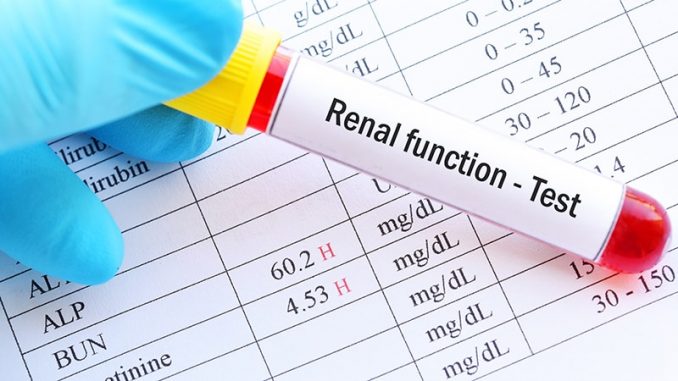
A person’s estimated glomerular filtration rate (eGFR), a mainstay for assessing renal function and health, can often substantially differ from that person’s actual, directly measured GFR (mGFR), a test performed far less often but which may now warrant a wider role as new evidence documents just how divergent mGFR and eGFR can be.

Tariq Shafi, MD
“Clinicians need to recognize that the eGFR is not an mGFR replacement and consider eGFR’s inaccuracy while managing individual patients,” concluded Tariq Shafi, MD, and his co-authors in a study published online in Annals of Internal Medicine on July 4.
“We hope that this work will motivate making directly measured GFR widely available,” said Shafi, director of the Division of Nephrology at the University of Mississippi Medical Center in Jackson, in an interview.
But other nephrologists say that the limitations of eGFR measures have been appreciated for years, and that the new report should have little impact on how assessment of kidney function is performed for the vast majority of US patients.
‘Not Something That We Have Not Known’
“This is not describing something that we have not known. The imprecision of an estimated GFR needs to be understood, but for more than 85% of patients,” assessment of kidney function by eGFR based on serum creatinine levels “is more than sufficient,” commented Paul Palevsky, MD, chief of the Renal Section of the VA Pittsburgh Health System and president of the National Kidney Foundation.
For many of the patients for whom a creatinine-based eGFR is not adequate, an eGFR based on blood levels of cystatin C can often suffice, Palevsky added in an interview. “For the vast majority of patients” a measured GFR, based on tracking the renal clearance of an injected bolus of iohexol, “is inconvenient and expensive.”
During his 38 years in practice, “I have never had to order an mGFR,” declared Palevsky, who is also a professor of medicine at the University of Pittsburgh.
The findings in the new report by Shafi “encourage the message we’ve been saying for a long time, and which are articulated in the chronic kidney disease guidelines [from KDIGO]: eGFR is an estimate and is a very appropriate first-line test for the vast majority of situations,” agreed Lesley A. Inker, MD, director of the Kidney and Blood Pressure Center at Tufts University School of Medicine in Boston.
The new report “confirms that eGFR is an estimate, and clinicians need to be thoughtful about that,” Inker said in an interview.
Shafi and his associates analyzed data from 3223 US adults who had been enrolled in any of four prospective cohort studies that recorded measurements of both their eGFR and mGFR. Their calculations showed that while the difference between eGFR and mGFR values was negligible across everyone in the study, the differences could be quite substantial in any one individual person.
eGFR and mGFR Difference Exceeds 20 mL/min/1.73 m2 in Some People
For example, among people who had an eGFR of 60 mL/min/1.73 m2 calculated using current, standard methods, the range of mGFRs for 95% of these people ranged from a low of 36 mL/min/1.73 m2 to a high of 87 mL/min/1.73 m2. This corresponds to a divergence of as much as 24 mL/min/1.73 m2 on the low side, and as much as 27 mL/min/1.73 m2 on the high side.
In contrast, for the entire cohort of more than 3000 people the median divergence between eGFR and mGFR was 0.6 mL/min/1.73m2 (with eGFR being the higher value).
“We are highlighting that reporting eGFR as a single number is incorrect. Many clinicians think that the reported eGFR on the lab report is the same as mGFR, but the distribution of uncertainty needs to be provided as well,” explained Shafi in an interview.
“If we say and believe that GFR is the best index for measuring kidney function, then we must try to make the best way to assess kidney function available to our patients. Directly measuring GFR is the best test to assess GFR, and it should be available for US patients,” stressed Shafi, who is also a professor of medicine at the University of Mississippi Medical Center.
mGFR Has Logistical Drawbacks
But the reality is that the current methods for directly measuring GFR are relatively expensive, cumbersome, and time-consuming and have limited availability, says Palevsky.
In contrast to measurement of serum creatinine, which usually costs $1 or less, or cystatin C, which may cost a few dollars, direct measurement of GFR based on clearance of an iohexol bolus from the blood costs perhaps a couple of hundred dollars, involves drawing multiple blood samples over a period of time, and has limited availability from commercial US laboratories.
In addition, Palevsky noted that while GFR is an important metric for assessing a person’s kidney function, it should never be relied on exclusively to track progression of chronic kidney disease. The level of a person’s albuminuria is a key, complementary measure that in many cases is even more important than eGFR. Changes in eGFR over time, and a person’s overall clinical history and presentation provide further, important guidance on kidney disease severity and trajectory and the appropriate course of management.
The study received no commercial funding. Shafi and Palevsky had no disclosures. Inker has been a consultant to Diametrix and has received research funding or advisory fees to her institution from the Chinnocks, Goldfinch, Omeros, Reata, and Tricida.
Ann Intern Med. July 4, 2022. Abstract
Mitchel L. Zoler is a reporter with Medscape and MDedge based in the Philadelphia region. @mitchelzoler
For more diabetes and endocrinology news, follow us on Twitter and Facebook
Follow Medscape on Facebook, Twitter, Instagram, and YouTube
Source: Read Full Article